Diving into an abstract floral fluid art project is thrilling—it’s all about vibrant colors, swirling effects, and creative flair! Start with a base coat of eggshell house paint mixed with Flowtrol and Global fine acrylic dark sea, then layer on dazzling hues like Prussian Blue and 24k gold. Use tools like the piggy paddle big mix stick to create smooth blends and a torch to zap bubbles for a flawless finish. Imagine spreading colors, like a painterly ninja, to craft stunning unicorn twists and dynamic designs that pop with emotional depth. Ready to release your inner artist and discover more techniques?
Key Takeaways
- Mix your base coat with a 4:1 ratio of Flowtrol to eggshell house paint for even fluidity.
- Use colors like Prussian Blue, 24k gold, and dark sea for vibrant, contrasting layers.
- Apply the ‘Ninja Swipe’ technique to blend colors and create dynamic, floral patterns.
- Utilize a torch to eliminate bubbles and ensure a smooth, polished finish.
Materials and Tools
When starting on an abstract floral fluid art project, gathering the appropriate materials and tools is crucial for achieving the best results.
Selecting the right paint types and tools guarantees that your artwork will have the desired fluidity and vibrancy. For this project, the base coat is a mixture of eggshell house paint and Global fine acrylic dark sea, combined using a ratio of 4 parts Flowtrol to 1 part paint. This base will provide a smooth and even starting point for your artwork.
In addition to the base coat, the color palette includes Global fine acrylic dark sea, Golden’s Prussian Blue, Deco Art 24k gold, and Artist Loft soft body white acrylic. These paints offer a range of hues and textures essential for creating depth and contrast. To add more variety, you can include quinine nickel AO gold, but remember to thin it with water if it’s too thick.
When it comes to tool selection, a fluid art Co piggy paddle big mix stick is recommended for applying paint and creating swirling effects. Additionally, using a torch is crucial for eliminating bubbles, guaranteeing a smooth and professional finish to your abstract floral masterpiece.
Mixing Paints
Properly mixing paints is fundamental to achieving the desired consistency and vibrancy in your abstract floral fluid art.
Begin by creating your base coat. Combine eggshell house paint with Global fine acrylic dark sea using a ratio of 4 parts flow trol to 1 part house paint. This mixture guarantees ideal paint consistency, laying a solid foundation for your artwork.
To enhance color saturation, incorporate vibrant hues. Add Golden’s Prussian Blue, Deco art 24k gold, and Artist Loft soft body white acrylic to your paint mixture. For added color variation, include quinine nickel AO gold. If your mixture becomes too thick, thin it with water to achieve your desired fluidity.
Using a fluid art Co piggy paddle big mix stick, mix your paints thoroughly. This tool is essential for achieving a smooth and even distribution of colors.
When layering your paints, start with the base coat, and then thoughtfully add the other colors. This method will help you create depth and intricate designs in your artwork.
Preparing Your Workspace
A well-organized and protected workspace is vital for creating abstract floral fluid art efficiently and effectively. Confirming workspace safety and implementing practical organization tips will help you focus on your creative process without unnecessary interruptions or accidents.
Start by covering your workspace with a protective layer, like plastic or drop cloths. This step is significant to prevent paint spills and stains from ruining your surfaces. Next, gather all your materials—paints, mixing tools, and canvas—and arrange them within easy reach. This setup will facilitate a smooth workflow and keep your creative momentum going strong.
It’s also important to have a designated drying area. Make sure this spot is away from direct sunlight and drafts to guarantee even drying and prevent dust from settling on your masterpiece. Keeping paper towels or rags nearby is another smart move. They come in handy for quick clean-ups and wiping excess paint from your tools, keeping your workspace tidy.
Finally, have a torch or heat tool ready to eliminate bubbles in your paint. This step guarantees a smoother finish on your fluid art piece.
- Cover your workspace with plastic or drop cloths
- Organize materials within easy reach
- Designate a drying area away from sunlight and drafts
- Keep paper towels or rags handy for clean-ups
Base Coat Application
Initiate the base coat application by mixing eggshell house paint with Global fine acrylic dark sea in a precise ratio of 4 parts flow trol to 1 part house paint.
The base coat is crucial for your abstract floral fluid art project, acting as the foundation that will make your colors pop and add depth to your final artwork. Ensuring an even application of this base coat is essential because it sets the stage for the entire piece, allowing other colors to adhere properly and ensuring a smooth, flawless finish.
As you spread the mixture across your canvas, take your time to achieve a uniform layer. An even application helps in creating those beautiful, dynamic patterns that fluid art is known for. Imagine this base coat as the blank page of an exciting story yet to unfold; it needs to be perfect to make the rest of your colors shine.
If you’re planning to use techniques like the Ninja Swipe, the base coat becomes even more significant. It interacts with the top layers to create unique effects, adding an element of surprise and creativity to your art.
Layering Colors
Layering colors in abstract floral fluid art is an exciting process that begins with a solid base coat for stability.
This is followed by the ‘Ninja Swipe’ technique to blend hues like Prussian Blue and 24k gold.
This method allows for vibrant, dynamic combinations that bring your artwork to life.
Utilizing the right mixing ratios and tools, such as a torch to remove bubbles, guarantees each layer is smooth and the colors remain vivid.
Color Layering Techniques
Mastering color layering techniques is crucial for achieving depth and visual interest in abstract floral fluid art. The interplay of colors not only enhances the visual appeal but also evokes emotional responses, leveraging principles of color psychology. Drawing abstract inspiration from floral motifs, artists can create engaging and dynamic pieces.
To achieve the best results, consider the following techniques:
- Mixing Ratio: Use a mixing ratio of 4 parts flow trol to 1 part eggshell house paint for smooth application and enhanced fluidity.
- Color Selection: Incorporate multiple colors such as Global fine acrylic dark sea, Golden’s Prussian Blue, and Deco art 24k gold to create depth.
- Ninja Swipe Technique: Blend the base coat with top colors using the ‘Ninja Swipe’ technique for unique designs and patterns.
- Piggy Paddle Big Mix Stick: Use a fluid art Co piggy paddle big mix stick to achieve natural paint pickup, creating intriguing ‘unicorn twists.’
These techniques not only imbue the artwork with complexity but also guarantee a smooth, professional finish. By thoughtfully layering colors, artists can transform a simple canvas into a mesmerizing abstract floral masterpiece.
Achieving Vibrant Combinations
Building on the foundational techniques of color layering, achieving vibrant combinations in abstract floral fluid art requires strategic color choices and application methods.
Start by using colors like Global fine acrylic dark sea, Golden’s Prussian Blue, and Deco art 24k gold, which create rich contrasts. These choices are significant for an eye-catching piece, as they adhere to principles of color theory and abstract inspiration.
For a vibrant base, mix four parts flow trol with one part eggshell house paint. This combination enhances the vibrancy of the colors applied on top.
When layering colors, it’s essential to follow a sequence that promotes blending. This method allows for the creation of deeper hues and intricate patterns, contributing to the artwork’s overall dynamism.
Using a torch to eliminate bubbles during the layering process is also critical. It helps maintain the integrity of the color layers, ensuring a smoother finish and more vivid colors.
Additionally, experimenting with the ‘Ninja Swipe’ technique can manipulate the layers of paint. This creates unexpected yet beautiful color interactions, adding to the vibrancy of your floral fluid art.
Understanding Ninja Swipe
The Ninja Swipe technique, integral to fluid art, involves swiping layers of paint across the canvas to create intricate and dynamic designs. This fascinating method allows artists to experiment with multiple colors and patterns, making each piece unique.
The Ninja Swipe encourages creativity and flexibility, as mistakes can be easily corrected by scraping off the paint and reapplying it until the desired effect is achieved. The process of natural paint pickup during swiping creates stunning patterns known as ‘unicorn twists,’ adding a layer of complexity to the artwork.
Using a variety of colors, such as white, gold, Prussian Blue, and dark sea, artists can achieve vibrant and dynamic results. A torch is often employed to eliminate bubbles, ensuring a smooth and polished finish.
- Encourages experimentation: Mistakes can be corrected by scraping off and reapplying paint.
- Creates intricate patterns: Known as ‘unicorn twists,’ enhancing visual complexity.
- Utilizes multiple colors: White, gold, Prussian Blue, and dark sea for vibrant results.
- Involves a torch: Eliminates bubbles for a smoother finish.
Understanding the Ninja Swipe is essential for anyone looking to master fluid art, offering endless possibilities for creativity and expression.
Swiping Techniques
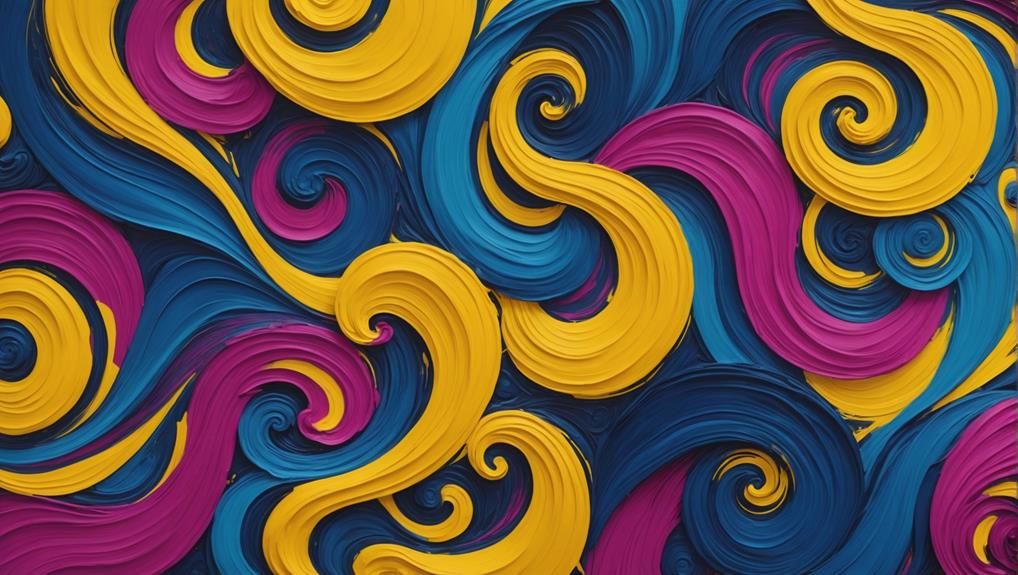
Swiping techniques in fluid art involve controlled movements to blend and layer colors, resulting in intricate and enchanting floral designs. One notable strategy, the ‘Ninja Swipe,’ allows artists to creatively control the application of paint, blending colors seamlessly to achieve unique floral patterns.
By using tools like a fluid art Co piggy paddle big mix stick, artists can layer and swipe colors such as white, gold, and Prussian Blue, creating intricate and mesmerizing designs. Employing these swiping strategies not only fosters creative expression but also enhances the final artwork’s depth and vibrancy.
Incorporating a base coat during the swiping process provides a visually appealing background, making the floral designs stand out. Additionally, utilizing a torch to eliminate bubbles during the swiping process contributes to a smoother finish, enhancing the overall appearance of the abstract floral piece.
Experimentation is key in fluid art, as these techniques encourage artists to explore different methods and effects. Mistakes can be easily scraped off and reworked into the design, allowing for continuous improvement and adaptation.
Ultimately, mastering swiping techniques enables artists to create enthralling and dynamic floral fluid art pieces that truly stand out.
Correcting Mistakes
Correcting mistakes in fluid art involves strategic techniques to refine the artwork without needing to start over, thereby maintaining creative momentum. Mistake correction is an integral part of the fluid art process, requiring both patience and adaptability. Here are some effective methods to help you fix errors and enhance your piece:
Scraping Off Excess Paint: If you notice a mistake, use a palette knife to gently scrape off the excess paint. This allows for fluid adjustments and gives you a fresh surface to rework.
Ninja Swipe Technique: This method encourages experimentation. By using swift, controlled swipes, you can blend colors and mask mistakes, creating new, dynamic patterns.
Incorporating the Base Coat: While swiping, blend the base coat into the design. This not only hides errors but also adds depth and uniqueness to your artwork.
Thinning Paint: Mix a little water into your paint to make it more fluid. This reduces the likelihood of unwanted textures and makes application smoother.
Using a Torch: A torch can be used to eliminate bubbles in the paint. This guarantees a more polished finish and helps in mistake correction by smoothing out the surface.
Creating Unicorn Twists
Creating unicorn twists in your floral fluid art can be an exciting and rewarding process.
By layering vibrant colors like Global fine acrylic dark sea and Golden’s Prussian Blue, you set the stage for these magical patterns to emerge.
As you master the swiping motion dynamics and experiment with different pattern formation strategies, you’ll discover how the fluidity of the paint allows for endless creative possibilities.
Color Layering Techniques
How can artists achieve mesmerizing visual depth and intricate patterns through the deliberate application of color layering techniques?
The answer lies in understanding color psychology and harnessing artistic expression. By thoughtfully applying multiple layers of colors like white, gold, Prussian Blue, and dark sea, artists can create rich, enthralling compositions. The interplay of these hues can evoke various emotions, adding a deeper layer of meaning to the artwork.
A key technique in this process is the use of a fluid art Co piggy paddle big mix stick, which aids in the natural pickup of paint, facilitating the creation of intricate ‘unicorn twists’. These twists add a magical, whimsical quality to the piece. Additionally, thinning colors such as Quinine nickel AO gold with water guarantees smoother application and blending, enhancing the overall fluidity and harmony of the layers.
Here are some tips to master color layering techniques:
- Experiment with various shades and tones to discover unique combinations.
- Utilize the ‘Ninja Swipe’ technique to integrate the base coat seamlessly.
- Thinning colors with water aids in achieving the perfect consistency.
- Use a mix stick to naturally pick up and layer paint.
2. Swiping Motion Dynamics
Mastering the swiping motion dynamics is essential for artists aiming to create intricate and dynamic ‘unicorn twists’ in their fluid art compositions. The ‘Ninja Swipe‘ technique is a game-changer, allowing you to layer multiple colors skillfully. By using a fluid art Co piggy paddle big mix stick, you can control the swipe dynamics and manipulate the paint to achieve unique designs and textures that truly stand out.
Adding a base coat during the swiping process is like giving your artwork a vibrant undercoat, making the top layers pop with depth and color. If you make a mistake, don’t worry! You can simply scrape off the paint and start over, making the process forgiving and open to experimentation.
To finish off, using a torch helps to eliminate those pesky bubbles that can ruin the smoothness of your final piece, ensuring your unicorn twists look flawless and professional. The combination of these techniques not only enhances the visual appeal but also adds a seamless blend of colors, bringing your abstract floral fluid art to life with mesmerizing patterns and textures.
3. Pattern Formation Strategies
Frequently overlooked, pattern formation strategies in fluid art are fundamental for achieving the mesmerizing ‘unicorn twists’ that define high-quality abstract floral pieces. These unique patterns are born from a blend of technique and creativity, giving each piece its enchanting allure.
One significant method is the ‘Ninja Swipe’ technique, which incorporates the base coat during the swiping process to create those magical unicorn twists. Using a fluid art Co piggy paddle big mix stick can be a game-changer, as it allows for precise application of colors, resulting in intricate designs.
Layering colors such as white, gold, Prussian Blue, and dark sea adds depth and complexity, making the patterns even more fascinating. Experimentation plays an essential role in pattern exploration; don’t be afraid to scrape off paint to correct mistakes or redefine patterns. Often, these adjustments lead to unexpected and beautiful outcomes.
The natural paint pickup during application contributes to the organic twists in the composition, enriching the overall design creativity.
- Utilize the ‘Ninja Swipe’ technique for unique patterns.
- Use a fluid art Co piggy paddle big mix stick for precision.
- Layer colors for depth.
- Embrace experimentation to discover new patterns.
Using a Torch
Using a torch in fluid art serves to eliminate bubbles in the paint, ensuring a smoother and more polished finish. Imagine you’ve just poured your beautiful abstract floral design, and tiny bubbles start popping up. That’s where the torch comes in!
Torch safety is super important; always hold it at a safe distance, like a superhero with a flamethrower, to avoid overheating or burning the paint. You don’t want to turn your masterpiece into a scorched mess!
The heat effects from the torch can do more than just pop bubbles. It can create these cool little cells that add depth and texture to your artwork, almost like magic!
But remember, with great power comes great responsibility. Use a butane or propane torch designed specifically for art purposes and follow all safety guidelines to prevent accidents. You wouldn’t want any fiery mishaps while you’re trying to create art.
Using the torch sparingly is key. Too much heat can lead to uneven surfaces or even damage your artwork. So, think of yourself as a careful wizard, using just enough fire to enhance your creation without causing chaos.
Happy torching!
Final Adjustments
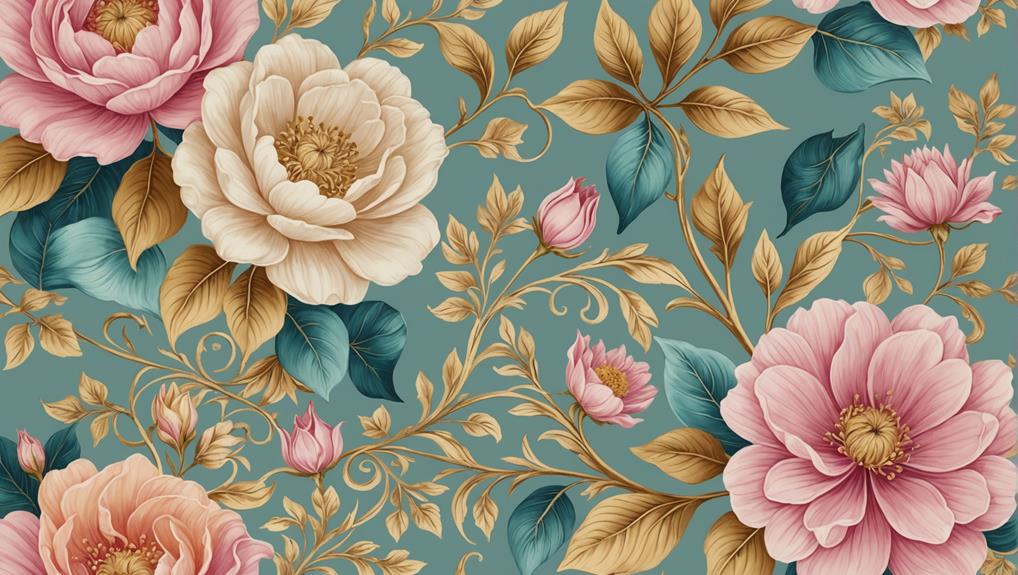
Final adjustments are where the magic happens, transforming an already beautiful piece into a true masterpiece.
Enhancing color vibrancy and refining pattern details can make a world of difference, bringing out the most stunning elements of the artwork.
Enhancing Color Vibrancy
To enhance the color vibrancy in abstract floral fluid art, artists often layer additional hues such as Golden’s Prussian Blue and Deco art 24k gold to create depth and contrast.
These choices resonate with color psychology, influencing how viewers emotionally respond to the artwork. This technique is an essential part of artistic expression, allowing artists to convey mood and atmosphere.
Enhancing color vibrancy involves several critical steps:
- Layering Colors: Applying multiple layers of vibrant hues can make the colors pop, adding depth and richness.
- Using a Torch: Running a torch over the surface helps eliminate bubbles, resulting in a smoother, more vibrant finish.
- Incorporating a Base Coat: During the swiping process, incorporating the base coat can create a dynamic background that enhances overall vibrancy.
- Thinning Paints: Thinning thicker paints, such as Quinacridone Nickel Azo Gold, with water can increase fluidity and improve color application.
Refining Pattern Details
After achieving enhanced color vibrancy, the focus shifts to refining pattern details to bring the artwork to its final polished state. This stage is where the magic happens, transforming a good piece into a stunning masterpiece.
Pattern interpretation plays a key role as you carefully observe the evolving design, trying to understand what each swirl and splash is telling you. Strategically applying additional layers of color can add depth, making the flowers seem almost lifelike.
Using a torch to eliminate bubbles doesn’t just smooth the surface; it helps create a polished look that makes the colors pop. Experimenting with layering techniques, like adding satin enamel, can create unique highlights, enriching the overall composition.
Incorporating the base coat during these final adjustments guarantees that colors and patterns blend seamlessly, enriching the visual experience. Observing the artwork in different lighting conditions can reveal hidden vibrancy, illuminating details that might not be evident under standard lighting.
This design evolution is all about fine-tuning and perfecting, ensuring every petal and leaf appears just right. By focusing on these final touches, your abstract floral fluid art will truly come to life, enchanting everyone who sees it.
Workshop Details
Hosted from June 25-27 at the Fitzpatrick Castle Hotel in Dublin, Ireland, the fluid art workshop provides a unique teaching environment for participants.
The workshop aims to immerse attendees in the world of fluid art, focusing on creativity, adaptability, and the mastery of techniques like the ‘Ninja Swipe.’ The goals of the workshop are clear: to expand artistic horizons, foster a collaborative spirit, and inspire each participant to develop their unique style.
Feedback from past participants has been overwhelmingly positive. They appreciate the hands-on approach and the opportunity to learn from expert instructors in an inspiring setting. The diverse backgrounds of attendees, ranging from amateurs to seasoned artists, create a dynamic learning atmosphere.
Instructors: Renowned fluid artists with years of experience.
Materials: All necessary supplies provided, from canvases to specialized paints.
Venue: Fitzpatrick Castle Hotel, offering luxurious accommodations and amenities.
Collaboration: Encourages networking and exchanging ideas with fellow artists.
Final Showcase: Participants can display their creations in a final exhibition.
The workshop’s collaborative environment encourages experimentation and interaction, enhancing the overall learning experience.
This unique setting, coupled with expert guidance, promises an unforgettable artistic journey for all attendees.
Techniques to Explore
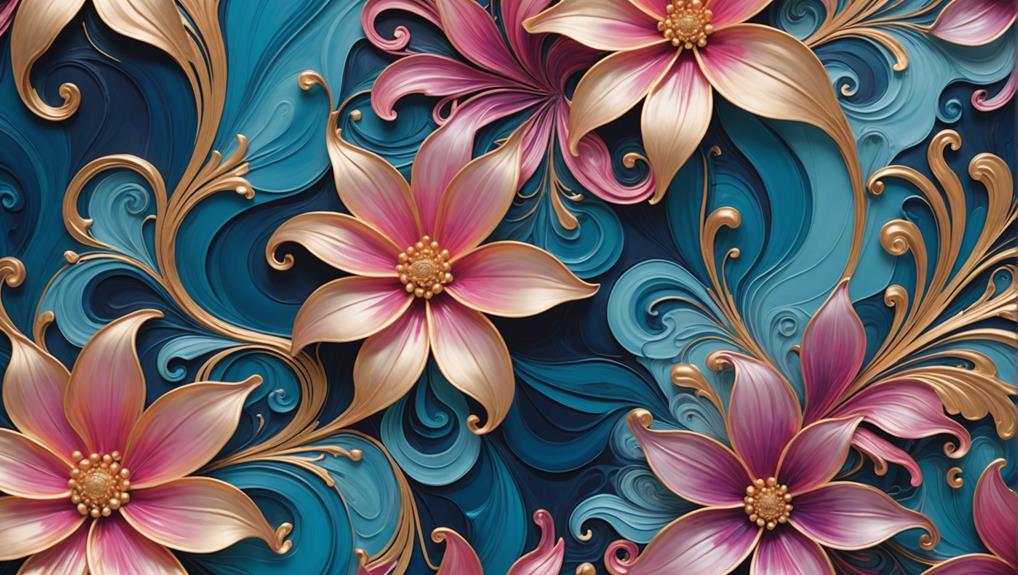
Exploring fluid art techniques can be an exciting journey, starting with color layering to create depth and vibrancy.
The ‘Ninja Swipe‘ method, combined with tools like the Co piggy paddle big mix stick, can produce stunning abstract floral patterns.
Additionally, using a torch to remove bubbles guarantees a smoother finish, making your artwork truly shine.
Color Layering Techniques
Mastering color layering techniques in fluid art is essential for creating depth and complexity in your compositions.
Understanding color psychology can greatly influence your artistic choices, allowing you to convey specific moods and emotions through your work.
Drawing from various artistic influences can also inspire unique and innovative approaches to your color layering process.
Incorporating multiple layers of colors such as white, gold, Prussian Blue, and dark sea can transform a simple piece into a visually enchanting masterpiece.
Here are some key techniques to explore:
- Base Coat Integration: Use the Ninja Swipe technique to blend the base coat into your layers, generating unique patterns.
- Vibrant Color Combinations: Mix eggshell house paint with Global fine acrylics, maintaining a ratio of 4 parts flow trol to 1 part house paint for vibrant, consistent colors.
- Bubble Elimination: Utilize a torch after applying each layer to remove bubbles, ensuring a smooth finish.
- Experimentation: Adjust your color placement and techniques to discover your unique style and achieve satisfying compositions.
Swiping for Patterns
Swiping techniques in fluid art, such as the ‘Ninja Swipe,’ provide artists with the tools to create intricate and dynamic patterns within their compositions. This technique is pivotal for pattern exploration and serves as a wellspring of creative inspiration. By employing tools like a fluid art Co piggy paddle big mix stick, artists can achieve a natural paint pickup that often results in intricate designs, sometimes affectionately termed ‘unicorn twists.’
The process begins with layering colors—white, gold, Prussian Blue, and dark sea—strategically to create depth and vibrant contrasts. The ‘Ninja Swipe’ technique involves gently dragging the stick through these layers, incorporating the base coat to produce unique floral patterns. Mistakes? No problem. The beauty of fluid art is that you can scrape off excess paint and try again, encouraging experimentation and artistic freedom.
Here’s a quick overview:
| Tool/Material | Purpose | Outcome |
|---|---|---|
| Fluid Art Co Piggy Paddle | Natural paint pickup | Intricate ‘unicorn twists’ |
| Layered Colors (White, Gold, Prussian Blue, Dark Sea) | Depth and contrast | Vibrant, dynamic floral patterns |
| Scraping Technique | Correcting mistakes | Encourages experimentation and artistic freedom |
Torch Usage Tips
Utilizing a torch effectively in fluid art not only eliminates air bubbles but also enhances the smoothness and visual appeal of the finished piece.
When working with a torch, it’s vital to prioritize torch safety and flame control to guarantee your artwork turns out beautifully without any mishaps.
Here are some essential tips for using a torch in your fluid art projects:
- Maintain a Safe Distance: Keep the torch about 6-12 inches away from the surface to prevent paint damage or accidental ignition.
- Use Sweeping Motions: Move the torch in a sweeping motion across the painted surface to distribute heat evenly and avoid overheating any single area.
- Timing Matters: Only use the torch after applying and leveling the paint; using it too early can alter the paint’s composition.
- Fire Safety: Always have a fire extinguisher nearby. Torches pose a fire risk if not handled properly, so being prepared is essential.
Student Experiences
During the fluid art workshop, students will have the invaluable opportunity to experiment with various colors and techniques to create their own abstract floral designs. This hands-on experience will allow them to explore methods such as the unique Ninja Swipe, adding layers of paint, and using tools like the fluid art Co piggy paddle big mix stick. Students will reflect on their creative processes and collaborate with fellow artists from across the US, fostering a vibrant learning environment.
Student Reflections and Creative Collaborations: The workshop, set against the picturesque backdrop of Fitzpatrick Castle Hotel in Dublin, Ireland, offers more than just technical skills. Participants will share their reflections and engage in creative collaborations, enhancing their understanding and appreciation of fluid art.
| Student Name | Favorite Technique | Memorable Experience |
|---|---|---|
| Alex | Ninja Swipe | Meeting artists from Maine |
| Jamie | Layering Paint | Using the piggy paddle |
| Taylor | Color Mixing | Tips from instructors |
Students will also get the chance to troubleshoot and refine their artwork with guidance from instructors, creating a supportive environment where everyone can grow. By the end of the workshop, they will have gained not just new skills but also lasting memories and connections with fellow artists.
Viewing Final Artwork
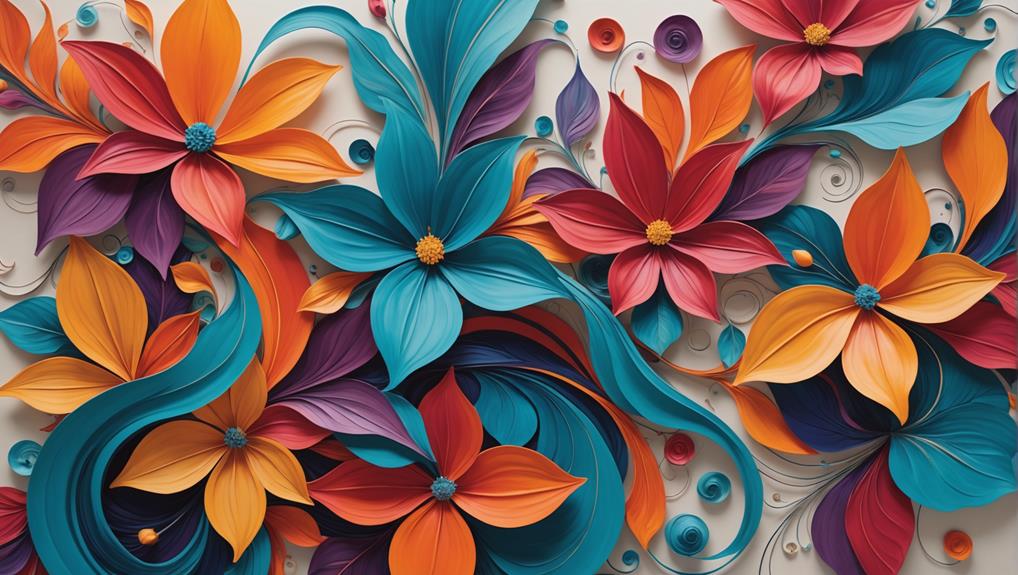
The final artwork, a stunning representation of the students’ creativity and skill, showcases a harmonious blend of vibrant color combinations and intricate patterns. This masterpiece, featuring hues like Global fine acrylic dark sea, Prussian Blue, and 24k gold, is an affirmation of artistic inspiration and viewer engagement.
The ‘Ninja Swipe’ technique used to create these intricate patterns adds a unique visual appeal, making the artwork stand out. The vibrant background color, more striking in person than in video, further enhances the viewer’s experience. Each piece is a product of meticulous layering and careful color application, resulting in a dynamic and rich composition. The collaboration with artist Nate Brigh introduces another level of creativity and expertise, making the final artwork even more impressive.
- Vibrant Color Combinations: The use of dark sea, Prussian Blue, and 24k gold creates a visually enchanting piece.
- Intricate Patterns: The ‘Ninja Swipe’ technique adds detailed and appealing patterns.
- Enhanced Background Color: The background appears more vibrant in person, adding to the artwork’s allure.
- Layered Composition: Careful layering of colors results in a dynamic final piece.
Frequently Asked Questions
Is Fluid Art Considered Abstract Art?
Yes, fluid art is considered abstract art due to its emphasis on fluid dynamics and artistic expression, prioritizing color, form, and movement over representational accuracy, thereby inviting personal interpretation and evoking emotional responses.
What Do I Need to Start Fluid Art?
To start fluid art, essential supplies include a base coat, various acrylic paints, a fluid art mixing stick, and a torch. Beginner techniques involve experimenting with color layering and swiping to create unique patterns and textures.
How Do You Make Abstract Art?
Creating abstract art involves drawing from inspiration sources and utilizing various artistic techniques. Experiment with colors, textures, and patterns through methods like layering, pouring, and swiping to evoke emotional expression and achieve unique, dynamic compositions.
What Kind of Paint Do You Use for Fluid Art?
In fluid art, acrylic pouring is the preferred technique, utilizing acrylic paints known for their fluid consistency. Adjusting paint viscosity with a pouring medium, such as flow trol, guarantees smooth application and stunning, vibrant results.
Conclusion
The abstract floral fluid art project introduces an engaging and innovative approach to art-making.
Through methodical preparation, precise layering, and exploration of various techniques, participants cultivate a unique artistic expression.
By providing a structured yet creative environment, this project fosters both technical skill and artistic intuition.
The culmination of this process is the creation of visually enthralling artworks, reflecting the diverse experiences and perspectives of each participant.
This project consequently serves as a valuable educational and creative endeavor.

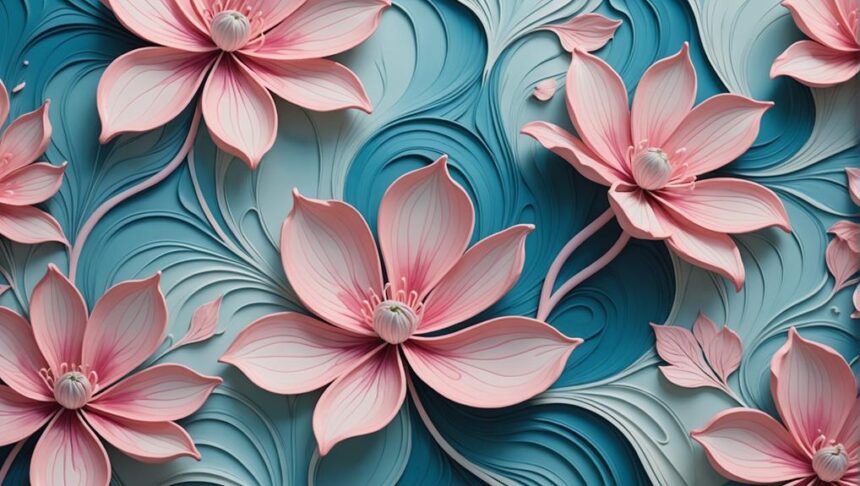
Leave a Reply